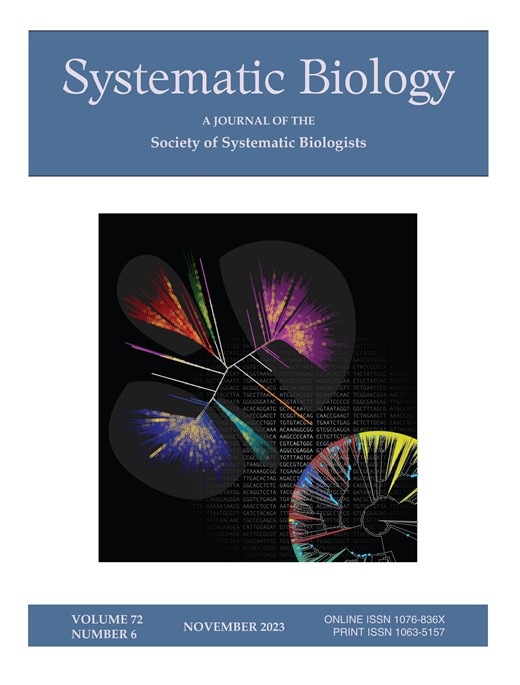迁徙对两个鸟类超科物种形成率的影响不一致:性状依赖多样化方法稳健性的检验。
IF 5.7
1区 生物学
Q1 EVOLUTIONARY BIOLOGY
引用次数: 0
摘要
季节性迁徙是由不同种类的种群在地球上的海洋和大陆上进行的。据推测,迁徙可以通过多种机制促进物种形成,这些机制可能引发生殖隔离和种群分化,如时间或空间的迁徙鸿沟、迁徙“下降”或新的、地理上孤立的繁殖区域的殖民化。迁徙也与最近少数几种鸟类的种群分化有关;然而,尚不清楚迁徙是否通常与较高的物种形成率有关。我们试图在两个具有不同迁徙表型的新世界鸟类的大分支,亚亚种和Emberizoidea中测试这个问题,采用了三种最先进的基于性状多样化的比较方法:使用1)BAMM和2)ClaDS估计尖端物种形成率;3)隐藏状态物种形成灭绝模型。我们的结果在不同的方法和不同的分类尺度上有所不同,这表明在得出一个给定的性状实际上促进了多样化的结论之前,迫切需要证实不同框架和数据集的推论。总的来说,基于不同方法的大多数结果,我们得出结论,没有方法上一致的证据表明这些群体的迁移谱系中物种形成更快。我们讨论了这一发现的生物学意义,以及当前基于性状的多样化方法所带来的推理挑战。本文章由计算机程序翻译,如有差异,请以英文原文为准。
No Consistent Effect of Migration on Speciation Rates in Two Avian Superfamilies: A Check on the Robustness of Trait-Dependent Diversification Methods.
Seasonal migration is performed by taxonomically diverse groups across the planet's oceans and continents. Migration has been hypothesized to promote speciation through a variety of mechanisms that may initiate reproductive isolation and population divergence, such as temporal or spatial migratory divides, migration 'falloffs', or the colonization of new, geographically isolated breeding areas. Migration has also been implicated in recent population divergence within a handful of bird species; however, it is unknown whether migration is generally associated with higher speciation rates. We sought to test this question in two large clades of new world birds with diverse migratory phenotypes, the suboscines and the Emberizoidea, employing three state-of-the-art comparative methods of trait-based diversification: estimates of tip speciation rates using 1) BAMM and 2) ClaDS; and 3) hidden-state speciation extinction models. Our results differed across methods and across taxonomic scales, suggesting an acute need to corroborate inferences across different frameworks and datasets prior to concluding that a given trait has, in fact, promoted diversification. Overall, and based upon the majority of results across different methods, we conclude that there is no methodologically-consistent evidence of faster speciation in migratory lineages in these groups. We discuss the biological implications of this finding, as well as the challenges of inference posed by current trait-based diversification methods.
求助全文
通过发布文献求助,成功后即可免费获取论文全文。
去求助
来源期刊

Systematic Biology
生物-进化生物学
CiteScore
13.00
自引率
7.70%
发文量
70
审稿时长
6-12 weeks
期刊介绍:
Systematic Biology is the bimonthly journal of the Society of Systematic Biologists. Papers for the journal are original contributions to the theory, principles, and methods of systematics as well as phylogeny, evolution, morphology, biogeography, paleontology, genetics, and the classification of all living things. A Points of View section offers a forum for discussion, while book reviews and announcements of general interest are also featured.
 求助内容:
求助内容: 应助结果提醒方式:
应助结果提醒方式:


